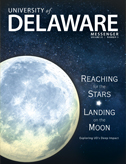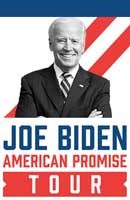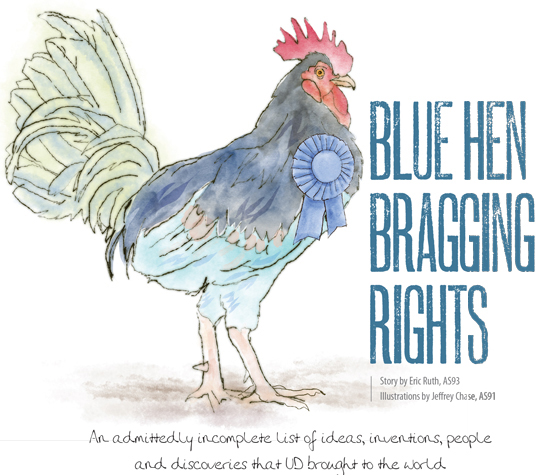
Look around the world, and you will see UD’s story told in the lives we collectively lead. Listen to the echoes of history, and you will hear of all that our scholars and students have accomplished. Pay attention to the voices of the people who seek progress and achievement and impact, and you can find proof of UD’s influence every day, everywhere.
Over its 274 years, the University of Delaware has stood as a powerful engine of the ideas, inventions, passions and progress that have been crucial to making the world a better place. From building a nation to battling fearful disease, the energies inspired at UD have reached many places, and shaped many societies, thanks, mainly, to the people who have stepped through its doors.
Here’s a look at how they—and the dreams they have chased—have helped change our world.
THE MEN WHO BUILT A NATION
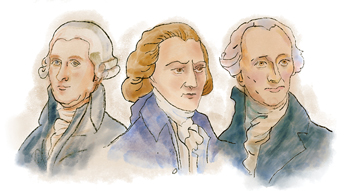
In the mid-1700s, the school that would become UD was just a tiny institution, with a graduating class of about a dozen. But the impact of this first class would be mighty. Three of those graduates—Thomas McKean, George Read and James Smith—would go on to sign the Declaration of Independence, and Read would also sign the U.S. Constitution, helping launch a new paradigm of freedom for an entire nation and a beacon of liberty for much of the world.
STOPPING POULTRY DISEASE IN ITS TRACKS
When another frightening bout of avian influenza threatens the food supply and human health, the world turns to UD for help. The University’s Avian Biosciences Center is considered a leader in fighting poultry diseases, training workers from around the globe on how to respond to outbreaks before the germs spread too far. In fact, this unified approach to outbreaks—stressing coordination by government, industry and universities—is known everywhere as the “Delaware Model.”

giving the gift of mobility
In the national media and in clinics around the world, there’s a growing buzz about how UD is helping children with limited mobility, thanks to the people of the GoBabyGo project, which has modified ride-on toy cars so youngsters can explore and socialize on their own for the first time, and its Super Suits Program, which allows rehabilitating children to move, play and learn more comfortably.
Preserving our past
An image can hold precious history, whether it’s a family snapshot or a ground-breaking painting. So when those photos and paintings are in dire need of restoration and preservation, the nation and world often turn to UD, where a partnership between the University and the Winterthur Museum, Garden & Library has created one of the nation’s top art conservation graduate programs–one of only five in North America.
Taking a closer look at art
Just over 50 years ago, there really wasn’t much scholarship being done on American art in its own universities. Sensing the void, two professors named E. Wayne Craven and William Innes Homer would go on to make UD’s Department of Art History one of the first national centers for the study of American art and culture here and around the world, a reputation that continues to this day.
Internet innovations
Way back in the days before electronics permeated our existence, a core group of brilliant pioneers established the framework for society’s now-ubiquitous, on-the-go computing prowess. Prof. David Farber helped develop an early computer network that linked universities nationwide. Prof. David Mills played an essential role in the development of network gateways and protocols that provide the backbone to today’s Internet. And alumnus Adam Osborne, EG66, 68PhD, would invent what is considered the world’s first commercially available portable computer—in 1981.

‘Superhero’ armor
Sometimes, even the softest things can be stronger than steel. That’s the counterintuitive genius behind Department of Chemical and Biomolecular Engineering Prof. Norman Wagner’s “liquid armor,” a fluid filled with nanoparticles that stiffens when force is applied, opening the potential for light-but-strong protective garments for soldiers, astronauts and others.
A mini Wall Street
Eager to prepare its students for the real-world dramas of Wall Street, UD decided to bring Wall Street to Newark, opening the 2,200-square-foot Geltzeiler Trading Center that replicates the trading floors of a top financial powerhouse. Through the center, which is named after alumnus and benefactor Michael, BE80, and his wife Rosann, students in finance, economics, hospitality, accounting and other classes put theory into practice while gaining real-world experience.
Overseas education pioneer
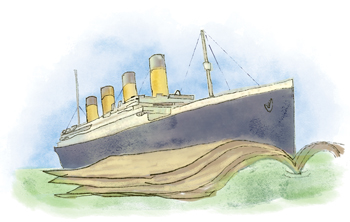
It began quietly, with a professor suggesting in 1923 that UD could enhance students’ learning by giving them an overseas experience. Influenced by the carnage he saw as an ambulance driver in WWI, Raymond Watson Kirkbride believed that understanding other cultures was critical to promoting peace. His idea would grow into an assortment of 100 study abroad programs that today include a third of all UD students, and routinely reach six continents, inspiring similar programs around the world. As the first in the country, UD’s study abroad has consistently set the example.
Educational outreach
The youngest minds are seen as a precious resource at UD, where the Partnership for Public Education is working to strengthen the quality of education for students from pre-K through high school, and the Delaware Institute for Excellence in Early Childhood has become a leader in efforts to improve programs meant for our youngest learners.
Letting leaders learn
Top executives and directors from the nation’s biggest corporations know they must continuously learn, and among the nation’s top learning centers for those execs is UD’s John L. Weinberg Center for Corporate Governance. At its helm is one of the country’s top experts on the esoteric art of running a big company, Prof. Charles M. Elson, whose pithy quotes are a regular element of big stories in The Wall Street Journal, The New York Times and other leading publications.
An industry epicenter
The U.S. biopharmaceutical industry, the great minds of academia, and state and federal agencies are putting their heads together to manufacture medicines more effectively—and they’re doing it at UD. The new National Institute for Innovation in Manufacturing Biopharmaceuticals is designed to “break down silos” and foster collaboration across stakeholder organizations so that companies face fewer barriers and risks—ultimately meaning enhanced patient access to medicines.
The show goes on
On Broadway, her name is legendary. At UD, she inspires enduring pride. For some 30 years now, Susan Stroman, AS76, 05H, has stood as one of American theatre’s preeminent choreographers and directors, winning five Tony Awards and becoming the first woman to choreograph a full-length ballet for New York City Ballet. But perhaps a highpoint of her career came when Mel Brooks asked her to direct and choreograph The Producers, which would win an unprecedented 12 Tonys.
A new window to our world

Nowadays, swiping the screen of your tablet or smartphone is as routine as eating. Chances are we’d still be pecking away on a keyboard had it not been for John Elias, a UD professor of electrical and computer engineering, and his then-student, Wayne Westerman, EG99PhD, who together developed the touch-tracking, sensing, typing and gesture recognition technology that enabled Apple to amaze the world with its state-of-the-art mobile devices.
Social media pioneers
When it comes to social networking sites, Facebook gets almost all the buzz. But for millions of university students in China, “renren.com” is the place to go—largely thanks to Joe Chen, AS92, who is the chairman and CEO of the firm and a prime force in the growth of such sites in China for over a decade. Interestingly enough, one of the social media sites gobbled up by Renren in its growth (Xiaonei) was founded by another UD alumnus, Wang Xing, EG04M.
Inspirational athleticism
A legend even before she left UD, pro basketball star Elena Delle Donne, EHD13, has become one of the most respected—and revered—athletes in the nation, appearing on magazine covers, winning an Olympic gold medal and uplifting people across the globe with her positive message of perseverance. And Blue Hens in Baltimore and beyond marvel at the indomitable fightin’ spirit of Ravens quarterback, 2012 Super Bowl champion and Most Valuable Player Joe Flacco, BE08, who set 20 school records at UD.
Preparing for trouble
In a world perennially pummeled by tsunamis, hurricanes and earthquakes, UD’s Disaster Research Center provides a crucial forum for understanding (and preparing for) the social impacts of these tumultuous events. As the first in the world devoted to the social scientific study of disasters, the center was started at Ohio State University in 1963 but has been based at UD since 1985.
Autonomous vehicles

One day in the not-too-distant future, we could find ourselves riding in so-called “self-driving” cars, steered by a computer and (hopefully) programmed to avoid collisions. At UD, one of the field’s top researchers, Mechanical Engineering Prof. Andreas Malikopoulos, is working to fine-tune the many technological challenges of such a miniature “smart city,” and other scholars are helping understand and assess the potential worldwide impact on safety, traffic congestion, jobs and the economy.
A truly powerful voice
People everywhere are inspired by the story of Joe Biden, AS65, 04H—how as a young leader he would overcome the tragic loss of his wife and child to pursue a life of public service; how he would become an influential senator credited with expanding our understanding of others, and our obligation to help those in need; how he would embrace the responsibility of being the second most powerful person on the planet, a vice president who still may very well claim the presidency. Now he’s leading the UD-based Biden Institute, which is poised to become a nexus of policy research, leveraging the ideas of top thinkers into solutions for a problem-filled nation.
Reaching for a STAR
So much about the Science, Technology and Advanced Research (STAR) Campus affirms UD’s uniquely practical role in improving people’s lives: Its open-to-the-public Health Sciences Complex focuses on providing the medical innovations and rehabilitation so many citizens need today, and its incubator spaces look toward fostering the kinds of businesses the state will need tomorrow. It’s a place perfectly suited for a century where industry and academia will work together for the benefit of all.
Big data = big opportunities
The future for big business, they say, lies in big data—in the reams of electronic information that can help companies analyze, customize, optimize and prophesize. UD has stepped to the forefront of this emerging field with its PhD program in financial services analytics, which uses data analytics to address the most critical issues facing businesses today.
'Sun Queen' still shines
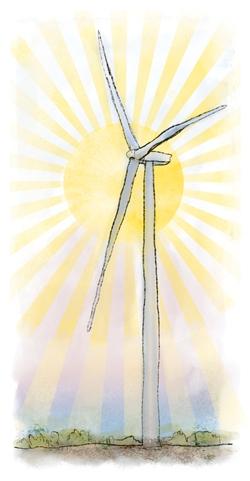
As the University was leading the charge toward a successful solar-powered home, a UD scientist named Maria Telkes would attain fame for her innovative solutions to the practical challenges posed by the project, devising ways to use the sun’s energy to provide home heating and power ovens. Known as the “Sun Queen” for her work, Telkes would be posthumously inducted into the National Inventors Hall of Fame.
A quest for clean energy
In today’s world, the sun and wind are seen as virtually inexhaustible sources of power—a fact that was made feasible in part through decades of work by such experts as UD’s Emeritus Prof. Karl Wolfgang Böer, who is recognized as a pioneer in efficient solar energy technologies, building the first home that used sunlight to power itself. His inspiration has led to a broader search for renewable, clean energy sources at UD, ranging from hydrogen fuel cells to wind farms to electric cars that can contribute excess power back to the grid.
Doing well—and doing good
By any measure, Tom Gutshall, EG60, is a successful man. But some would say this engineer and entrepreneur’s greatest successes aren’t measured in dollars, but in the number of lives saved. The company he co-founded, Cepheid, has addressed problems that many profit-minded companies would avoid, from inventing anthrax detection equipment in the wake of the 2001 scare, to creating a molecular diagnostic test for the Ebola Zaire virus that enables fast diagnoses in some of the most remote regions in the world. His years as head of Cepheid confirmed his belief that “you can charge reasonable prices for drugs and medical devices and still be successful.”
The Delaware Wing-T
It’s certainly old, and even kind of old-fashioned compared to the glitzy formations of today. But for about 67 years, the Delaware Wing-T Offense has been an enduring staple of college, high school and even some pro teams around the nation, thanks to its versatile and deceptive nature. Developed by revered Blue Hen Coach Dave Nelson and refined under the leadership of coaching legend Tubby Raymond, the Wing-T is hard to stop, and unlikely to fade from football’s playbooks anytime soon (even if it is no longer used at UD).
A fabric like no other
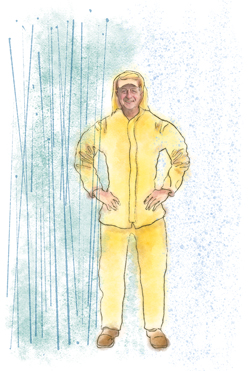
While he was still a student at UD, Bob Gore, EG59, 10H, was already on the road to greatness. Working with his father, he happened upon a new way of coating electrical wires with Teflon, which would eventually provide a launching pad for establishing his father’s company, W.L. Gore & Associates. A few years later, he found a way of stretching that Teflon so that it acquired properties like “breathability” and water resistance. We know it today as Gore-Tex, an essential ingredient in weather-ready clothing and even space suits. The company is led by another Blue Hen, Terri Kelly, EG83.
Guarding cyberspace
The nation’s top executives probably sleep better at night knowing they have people on their side like Dave DeWalt, EG86. As Chairman and CEO of FireEye, DeWalt has built one of the world’s preeminent cybersecurity firms, investigating one high-profile hacker attack after another, from Sony Pictures to the recent Equifax breach that potentially exposed the personal information of 143 million people. Every day, in nations around the globe, FireEye’s system of “virtual machines” guards against hackers for firms such as Visa, General Electric, Facebook and even the National Security Agency.
A very special collection
There are things in the Special Collections section of the UD library you would expect—rare books of art, history and literature; valuable examples of fine bookmaking and lithography. But it’s the more eclectic rarities that surprise: copies of the Emancipation Proclamation and 13th Amendment, signed by Abraham Lincoln; manuscripts and correspondence from Ernest Hemingway, Kurt Vonnegut, Tennessee Williams and others; the rare materials on alchemy that still draw Harry Potter fans to UD; the first edition of Isaac Newton’s Principia; and more than 9,500 items of Victorian literature and art from the Mark Samuels Lasner collection, to name just a few.
Mending bodies
There is no better place in the country to get a doctoral degree in physical therapy. That’s according to the influential U.S. News and World Report college rankings, which has also put a variety of UD programs among the best in the nation: UD’s chemical engineering graduate program is ranked ninth in the nation, and UD’s College of Engineering overall graduate program ranked 51st. In addition, five other graduate programs are listed among the nation’s top programs: education (35), public affairs (45), part-time MBA (51), chemistry and biochemistry (60), and psychological and brain sciences (67).
And the Nobel goes to
Today, slicing and splicing DNA is a routine part of biotechnology, allowing science to unravel the mysteries of the genome and develop life-saving medicines. All of it was made possible by the research of Dr. Daniel Nathans, AS50, 79H, who would share the Nobel Prize for Physiology or Medicine in 1978 for helping to discover how cells use enzymes to snip strands of DNA, allowing future generations of scientists to examine the genetic information they contain—his work paved the way for the development of prenatal tests for such diseases as cystic fibrosis and sickle cell anemia.
The Watchdog

Newspapers are struggling in an era of ”fake news” and ”alternative facts.” But for the past 28 years, the Center for Public Integrity has stood as the nation’s largest nonpartisan, nonprofit investigative news organizations, thanks to its founder Charles Lewis, AS75. This Washington, D.C.-based organization has won two Pulitzer Prizes since 2014—the first for its reporting on the coal industry’s efforts to fight black lung disease claims, and again this year for offshore financial hideaways used by heads of state and celebrities.
The key to the puzzle
For generations, UD has been known for the quality of its chemistry programs, its faculty and its graduates. One of the most significant developments came from the late Prof. Richard Heck, who would share a Nobel Prize for his discovery of the Heck reaction, which gave chemists a groundbreaking new tool for pharmaceutical discovery, DNA sequencing, advanced electronics and more.
Wait, wait, there’s more
As we mentioned before, this is an admittedly incomplete list, as one article could never begin to encapsulate the countless contributions UD has given the world. If you’ve noticed something missing, please share your suggestions with us at TheMessenger@udel.edu and we’ll include it in our spring issue.
